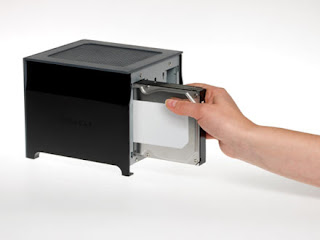
 It's worth me just mentioning quickly the Stora's architecture. It's a 2 hard drive NAS unit that provides digital storage for users on the network. It can act as a DLNA server allowing music, pictures and videos to be streamed over the network to games consoles and other computers. It is compatible with Apple products supporting an itunes interface, and provides shared network folders for windows or linux computers to access. The drives can be logically arranged in one of two formats; either mirrored so that all data is duplicated on both drives offering maximum redundancy or striped so that storage capacity is maximised as the full capacity of both discs is available to the user, but offers no redundancy. I have mine in the mirrored format. There are three lights on the front of the unit, the first is a power light, the second for hard drive 1 status and the third for hard drive 2 status; green for good and amber for a problem.
It's worth me just mentioning quickly the Stora's architecture. It's a 2 hard drive NAS unit that provides digital storage for users on the network. It can act as a DLNA server allowing music, pictures and videos to be streamed over the network to games consoles and other computers. It is compatible with Apple products supporting an itunes interface, and provides shared network folders for windows or linux computers to access. The drives can be logically arranged in one of two formats; either mirrored so that all data is duplicated on both drives offering maximum redundancy or striped so that storage capacity is maximised as the full capacity of both discs is available to the user, but offers no redundancy. I have mine in the mirrored format. There are three lights on the front of the unit, the first is a power light, the second for hard drive 1 status and the third for hard drive 2 status; green for good and amber for a problem.With both drives containing all data it makes the upgrade a lot simpler. In theory, I don't have to copy all the data to another drive as the Stora is designed to allow a failed disc to be replaced with a new one. I seriously considered copying all the data to a 2nd location but decided that as both discs in the Stora had an identical copy of my data on them I already had a high degree of redundancy. If I encountered any problems, I could always put the removed drive back in to recover.
So, first I powered off the system. It is designed to allow hot-swapping of drives, but I decided the likelihood of damaging a drive whilst the heads were still spinning was a little too high for my liking. I removed the first drive, replaced it with the first new 2TB, and turned the unit back on. As expected, one of the little drive lights was amber indicating a problem with the new disk. A quick trip into the unit's management web page and it reported the problem that disk 1 was not ready, had detected the new drive and asked what to do. I told it to include the new drive into the array. The unit then formatted the new disk and copied all the data from the original disk onto the new disk. This was a surprisingly quick process and took a little under 2 hours.
Once complete, I checked the unit was functioning and then powered it off again. Removed the last original disk and replaced it with the new 2TB disk and powered the unit on again. As before, it detected the new disk but needed to know what to do with it. Another trip to the management web page and I added the new disk to the array and the formatting and data copying commenced again. 2 hours later this process finished. This was when I realised that although the new drives were working fine and had been recognised by the unit, the partition tables had also been copied allowing only the original 1TB of space to be available. The only way I was able to make the full 2TB available was to copy all my data to the removed drives by putting them in my desktop computer and to then reformat the entire Stora. This last step was somewhat annoying, but I now have a 2TB unit with plenty of space on it.
It is worth mentioning that the Stora is designed to be easy to use, so there are no disk partitioning options at all. The only option is to have either a mirrored or striped configuration. All capacity on the drives will be used. In mirrored mode, the maximum capacity is the size of the smaller drive.
I've yet to hear whether there is any potential to expand this unit further, but suspect that as the hardware is a few years old now, 2TB is probably the maximum disk size this unit can accommodate. For me, this is more than enough for the next year or so, and after that I will start looking at systems with space for more than 2 disks. Currently, QNAP is my favourite, but let's see what comes out in the next year.



